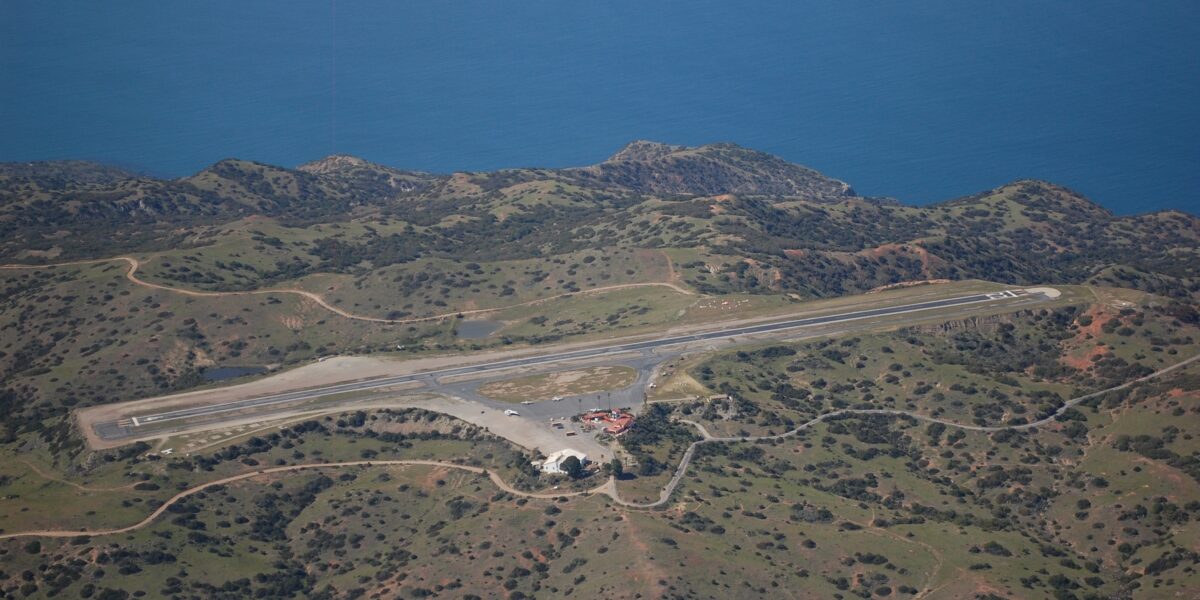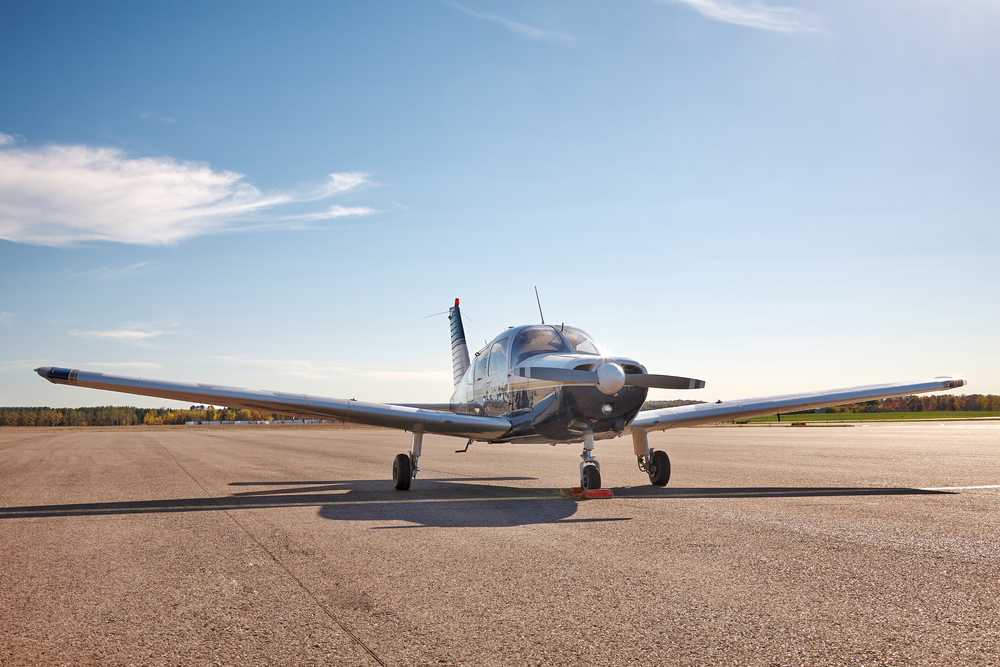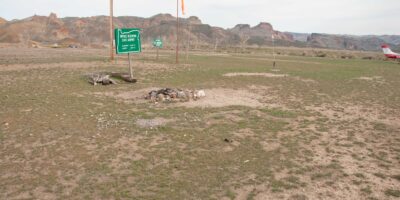Catalina Airport sits atop Santa Catalina Island, 22 miles off the California coast. This unique destination combines challenging approach procedures with spectacular scenery and island resort amenities. The 3,250-foot runway at 1,602 feet elevation serves as the only airport on the island. Flying to Catalina has been a Southern California pilgrimage for decades, offering pilots a memorable island getaway just minutes from the mainland.
Quick Answer: Catalina Airport (KAVX) features a 3,250-foot runway at 1,602 feet elevation with a 1.7% upslope to the west. Operations use Runway 22 for arrival and Runway 04 for departure due to terrain and noise abatement. The island location requires overwater navigation. Landing fee is $35 for singles, $70 for twins. DC-3 Grill restaurant operates on-field. Accessible year-round but marine layer often closes the airport mornings in May-July.
Airport Layout and Runway Details
The single runway (04/22) measures 3,250 feet long and 100 feet wide. Paved asphalt surface in good condition. Field elevation is 1,602 feet. The runway has a 1.7% gradient upslope to the west. This slope significantly aids westbound landings and eastbound departures. Both runway ends have clear approaches, but terrain rises on all sides.
The airport sits on a plateau in the island’s interior. Mountains rise to over 2,000 feet to the northwest. The eastern approach descends toward the ocean. No lights exist—the airport is day VFR only. Fuel (100LL) is available with advance notice but not guaranteed—most pilots fuel on the mainland. The single small ramp accommodates 15-20 aircraft.
Standard Operating Procedures
Catalina uses published right-traffic patterns. The standard procedure is landing Runway 22 (westbound) and departing Runway 04 (eastbound) regardless of wind. This one-way operation prevents noise over the town of Avalon and provides better terrain clearance. However, direct crosswinds or strong tailwinds may require opposite-direction operations after coordinating with Unicom.
Inbound aircraft contact Unicom (122.8) 10 miles out to announce intentions. The CTAF frequency is 123.0. Position reports include distance and direction from the airport. Overfly midfield at 2,000 feet to enter downwind for Runway 22. The right pattern keeps aircraft away from rising terrain. Final approach descends through 1,800 feet about 2 miles out.
Overwater Navigation
The 22-mile overwater crossing requires preparation. Fly at 3,500+ feet to maintain gliding distance to shore in case of engine failure. Wear life preservers—required for flights beyond gliding distance from shore. Carry a life raft if flying at night or in instrument conditions. Brief passengers on ditching procedures.
Typical routes depart Long Beach, Torrance, John Wayne, or other coastal airports. Direct routing works, but some pilots follow the coastline slightly before crossing. GPS navigation makes the crossing straightforward, but carry paper charts as backup. Monitor 121.5 emergency frequency. Check weather at both departure point and Catalina—conditions differ significantly between mainland and island.
Weather Considerations
Marine layer fog blankets the island frequently May through July. The layer typically burns off by noon but can persist all day. No weather reporting exists at Catalina—pilots must assess conditions visually or obtain pilot reports. Mainland weather doesn’t predict island conditions reliably. Always have an alternate plan with fuel to return to the mainland.
Afternoon sea breezes develop daily, creating crosswinds. Wind speeds increase in afternoon heating. Turbulence occurs over the ridges surrounding the airport. Morning flights generally offer smoother conditions. Santa Ana wind events bring strong easterly winds and excellent visibility but challenging landing conditions. Winter storms close the airport with low ceilings and high winds.
Landing Technique
Approach Runway 22 from the east, descending through the pattern. The upslope runway aids deceleration significantly. Aim for the numbers to maximize rollout distance, though the upslope shortens landing roll to 1,000-1,500 feet for most aircraft. Maintain approach speed to avoid sinking short of the threshold—terrain drops off steeply.
The displaced threshold on Runway 22 protects aircraft on departure from Runway 04. Land beyond the displaced portion. Tower and terrain create optical illusions—use instruments to maintain glidepath. The 100-foot runway width feels narrow compared to mainland airports. Centerline discipline matters. Light aircraft handle the runway easily; larger twins and turboprops operate regularly.
Departure Procedures
Departures use Runway 04 following the downslope. Backtaxi the full length to the Runway 22 end. The downhill slope provides significant acceleration help. Most aircraft are airborne in 1,000-1,500 feet. After liftoff, turn right to parallel the island’s spine, avoiding the town of Avalon to the south. Climb to cruise altitude before crossing the shoreline.
The downslope makes departures comfortable even on warm days. Density altitude is rarely a factor at 1,602 feet elevation near sea level. However, always calculate performance, especially with full passenger and baggage loads. Abort capability is good due to the downslope—you can stop if performance seems inadequate by mid-runway.
On-Island Activities
The DC-3 Grill restaurant operates at the airport, serving meals in a vintage DC-3 fuselage. The restaurant provides the main reason many pilots visit. The Airport-in-the-Sky nature center educates visitors about island ecology. Hiking trails wind through the interior. Buffalo roam the island—occasionally visible from the airport.
Shuttle buses transport visitors to Avalon (13 miles, $35 round trip) or Two Harbors. Avalon offers restaurants, shops, and tourist activities. Advance shuttle reservations are recommended. Some pilots bring bikes to explore. Camping is available in designated areas with permits. Most pilots spend 2-4 hours on the island before returning to the mainland. The airport camping area accommodates pilots wanting to overnight.
Fees and Regulations
Landing fees are $35 for single-engine aircraft, $70 for twins and turbines. Pay at the airport office. Overnight tiedown fees apply if staying past sunset. The island is part of Los Angeles County but feels remote and rural. Noise abatement is critical—the airport faces closure threats periodically. Follow all published procedures to maintain community relations.
No advance reservations are required for day trips. The airport can refuse service during peak weekends if ramp space is full. Weekday visits encounter fewer crowds. Spring and fall offer the best weather and fewer crowds compared to summer. The island’s unique environment and challenging flying make Catalina a bucket-list destination for Southern California pilots. Treat the island respectfully to ensure future generations can enjoy this aviation treasure.



Leave a Reply